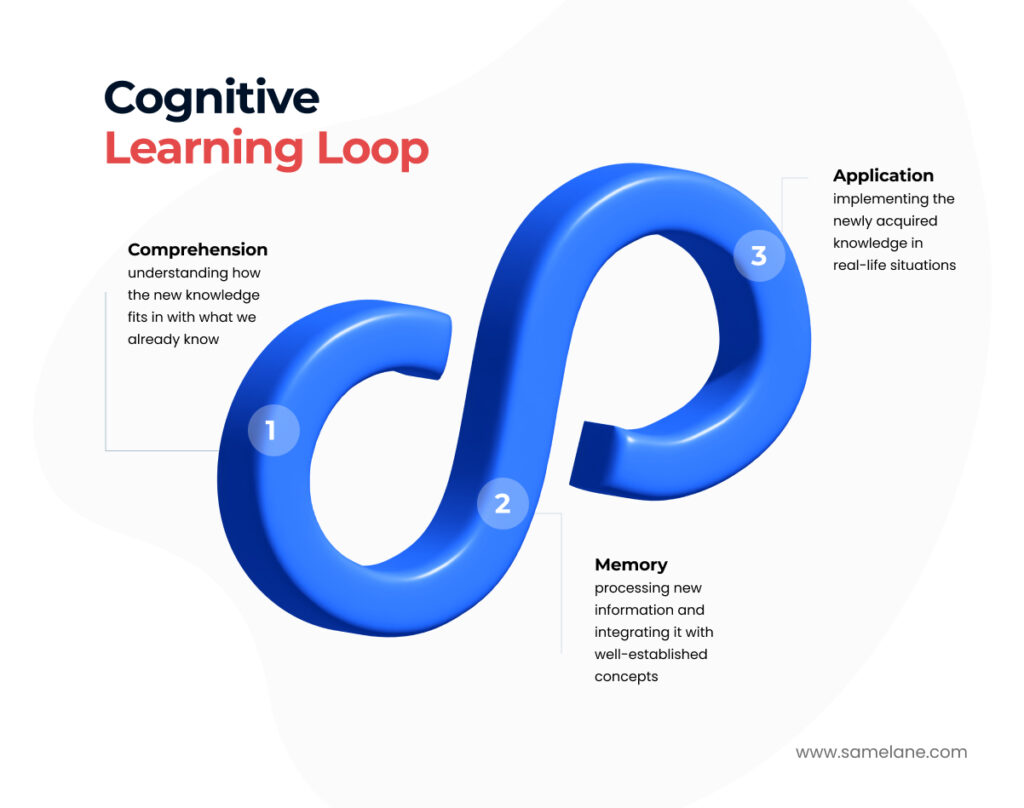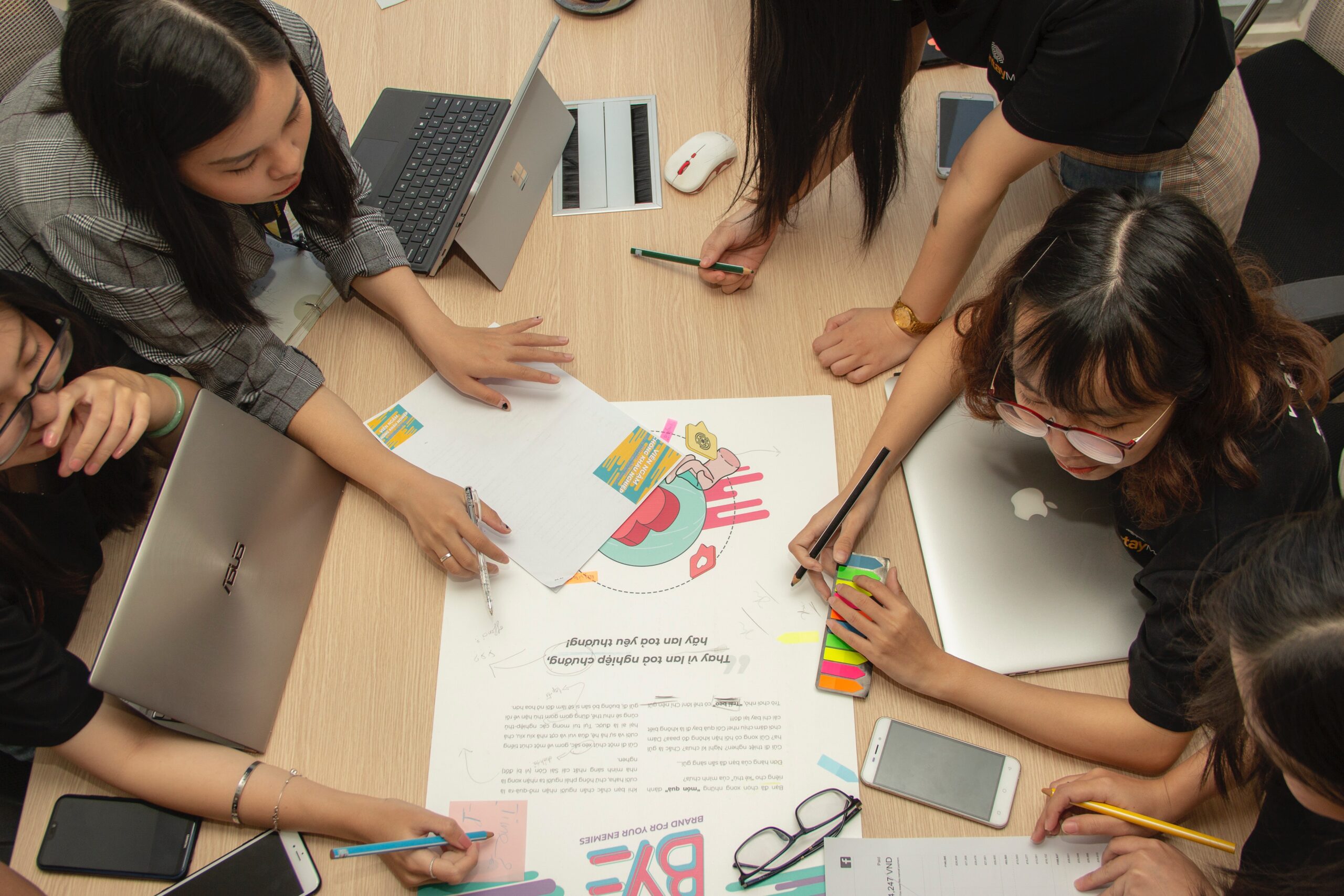To understand the cognitive learning theory, it’s worth looking into how the human brain learns and processes information. It is indeed a fascinating concept, to begin with. According to the cognitivist theory, our mind actively constructs knowledge when we absorb new facts. They build up on the fundaments of the resources our brain already gathered. Just as with a jigsaw puzzle, single elements connect well with the whole picture if you find the spot they belong to. Our brain constantly learns, organizes, and interprets information. It’s a lifelong process that you can actively facilitate. Strengthening your cognitive learning skills can positively impact your career but also the remaining aspects of life. This article will expand on cognitive strategies and provide practical examples of cognitive learning.
What is the theory of cognitive learning?
Based on the mechanisms of human brain perception, the cognitive learning style encourages an active approach to gaining knowledge. The learner’s mind engages with information holistically through seeing, thinking, experiencing, and interacting. Hence, cognitive learning is perceived as more meaningful and proceeds on a deeper level than other learning styles based on single-sense acquisition, like verbal or visual. The multisensory approach maximizes the capacity to learn, process, and memorize information.
Cognitive learning consists of three steps that make up the Cognitive Learning Loop. The first one is comprehension; it focuses on understanding how the new knowledge fits in with what we already know and why it is worth adding to our “knowledge base.” Comprehension takes place while reading, listening, and viewing the content. Nextly, in the memory phase, our brain processes new information and integrates it with previous experiences and other well-established concepts. Building deep knowledge happens gradually and might consume more time than simple memorization or the cramming practice used by students aiming only to pass the exam. However, it is way more effective in the long term, leading to a better, more profound understanding of the subject. Application is the last step, where we implement the newly acquired knowledge in real-life situations when interacting with co-workers and transferring the information. The Cognitive Learning Loop can be fully applicable in a corporate environment. By exercising this active learning style, employees can accelerate their potential through a deeper understanding of the industry and improved knowledge retention.

What do cognitive theories focus on?
Cognitive learning theory tackles the nuances of mental processes occurring while we take in, adapt, and memorize new information. The actual term (CLT) was coined in 1936 by Jean Piaget, an educational psychologist. His studies were conducted on infants and young children, though they can be applied within a broader context. Piaget proved that knowledge is actively constructed in the process of learning, during which our brain relates the new information with earlier experience. Our brain observes, admits, categorizes, and interprets all information to eventually add it to the continuously expanding knowledge base. What is more, knowledge acquisition processes occur internally and externally, as human beings process and store information but also interact with the surrounding environment. Despite the dynamic character of the process, the cognitive theory states that the knowledge-building process, in large part, is conducted through a passive information intake like listening, viewing, and reading.
The CLT splits into two sub-theories: Cognitive Behavioral Theory and Social Cognitive Theory. In a nutshell, the behavioral approach explores the influence of mental processes and thoughts on learning, while the Social faction focuses on how human interaction impacts cognition. But let’s look into the details.

Cognitive Behavioral Theory
According to CBT, human mindset and thoughts determine how we learn and retain information. The theory explains how thoughts shape our emotions, which in turn have a huge impact on our attitude toward learning. For example, if your thoughts revolve around completing a task, you will probably feel self-motivated, and as a result, your willingness to act will increase. As you can see, it’s a self-propelling system that we can influence. Referring to the Harvard Business Review article, we are able to develop the abilities of successful learners through exercising self-awareness and nurturing our curiosity and aspirations.
Social Cognitive Theory
This approach, in turn, explores the effect of social interaction on our learning processes. SCT posits that learning happens in a social context, within a dynamic and reciprocal interaction between people, their behavior and experiences, and the environment. Following Social Cognitive Theory, knowledge acquisition happens due to four notions: observation, retention, reproduction, and motivation. While the CBT focuses exclusively on internal motivation, the SCT emphasizes both internal (retention and motivation) and external (observation and motivation) factors.
What are the Cognitive Learning Strategies?
Learning abilities can be developed, as every other skill we decide to master. There are several effective strategies that can help enhance the learning capabilities of your employees. Here are the four examples of cognitive learning strategy to enact:
- Learner-centered strategy
This strategy is all about relating new knowledge to the information we have already acquired. Learners are welcome to share their thoughts and experiences associated with the subject matter whenever new content is brought up. Hence, highlighting analogies and introducing new facts in relation to the base knowledge is highly advisable.
- Learning through discovery strategy
In this case, learners gain knowledge through exploration. Apart from the knowledge itself, this strategy develops analytical and problem-solving skills. Our memory works better when we are emotionally involved in solving the issue, but also when we deal with something new, thus stimulating.
- Meaningful learning strategy
This approach is the exact opposite of the well-known rote-learning or cramming strategy. It emphasizes the practical value that new knowledge brings. Providing background information is essential for a better understanding of the new data.
- Personalized learning strategy
Strategy focused on the personal approach does not focus on individual learners but on creating a learning experience and environment matching the level and knowledge background of the participants. Providing the opportunity to study at the most suitable time, setting learning tracks, and providing more personalized and well-matched training becomes much easier due to modern technologies, such as LMS platforms.
Examples of cognitive theory
Cognitive learning is a meaningful and engaging approach to gaining knowledge that involves the learner on a multisensory level. In effect, our brain expands its potential like our body does through a regular workout. Our memory capacity grows, and so does knowledge retention. The examples of cognitive learning below, matching the strategies explained above, will help you expand your learning capabilities.
- Explicit learning occurs when we are willing to learn and seek knowledge. We are driven by inner motivation, as we have set ourselves a clear objective.
- Implicit learning happens unintentionally while you’re in the middle of doing something else. Passive knowledge absorption comes automatically with time and usually applies to repetitive activities.
- Meaningful learning works best when we expand our knowledge in a given subject. We deepen our understanding by adding new information to the already gathered knowledge base.
- Experiential learning is based on gaining knowledge through active participation. Gaining practical experience stimulates our brain, at the same time strengthening knowledge retention.
- Observation learning involves reception and imitation. First, information is absorbed passively so the learner can repeat through imitation and memorize the new knowledge.
Benefits of cognitive learning
Supporting cognitive methods in the workplace is undoubtedly a good idea, as CLT makes learning nothing less than a stimulating experience. When investing in employee development, you expect them to get a deeper understanding of industry knowledge and be able to use it in practice. Cognitive methods go hand in hand with the modern LMS platforms offering a comprehensive learning experience. Interactive social learning, animated webinars, and quizzes will provide an immersive learning experience to your employees, enabling an in-depth understanding of the training material. Cognitive benefits go further than just gaining knowledge. Through the active acquisition, your employees will enhance their problem-solving comprehension and confidence. After experiencing the positive results of cognitive learning, course attendees gain a solid confidence boost and are more willing to participate in further courses. You can implement cognitive learning with Samelane LMS, which, thanks to diverse functionalities and interactive formats, makes it possible to deploy the methodology in any organization. Feel free to contact us for a free demo presentation. We will be happy to present our platform’s possibilities and features and answer any questions.











